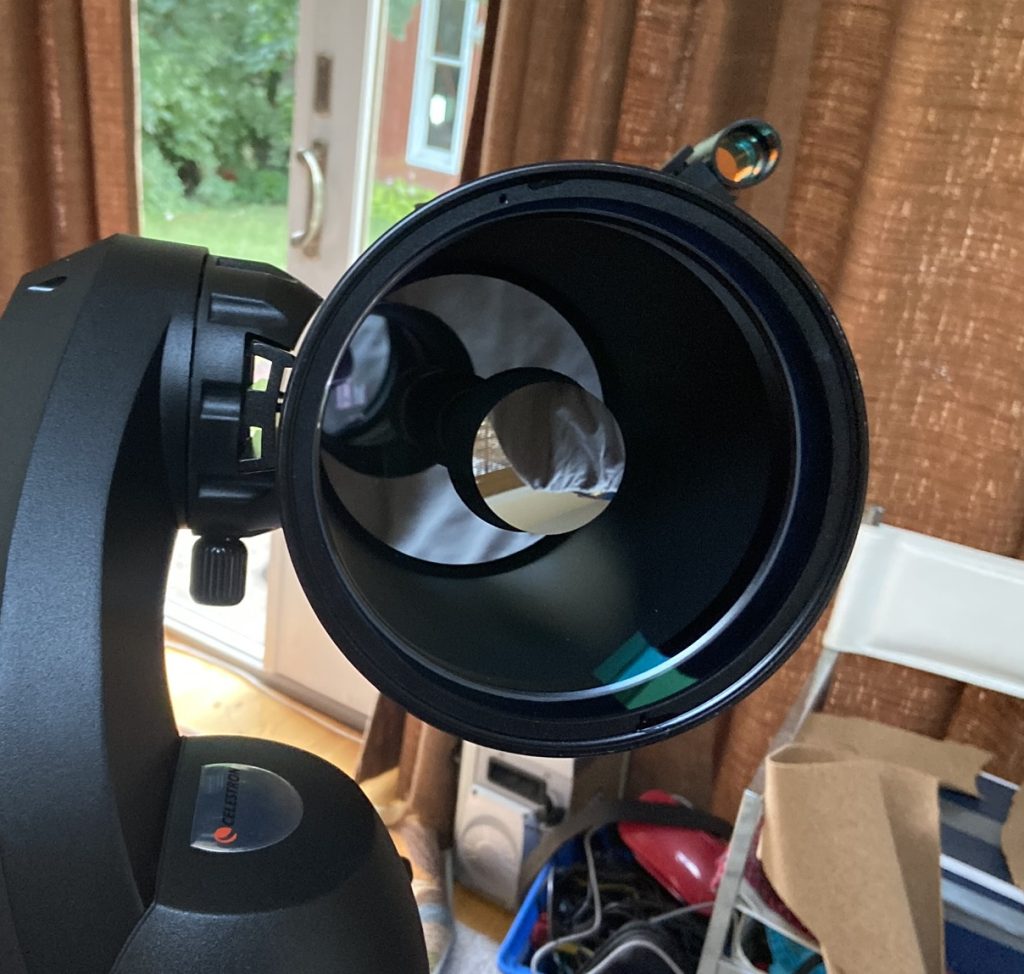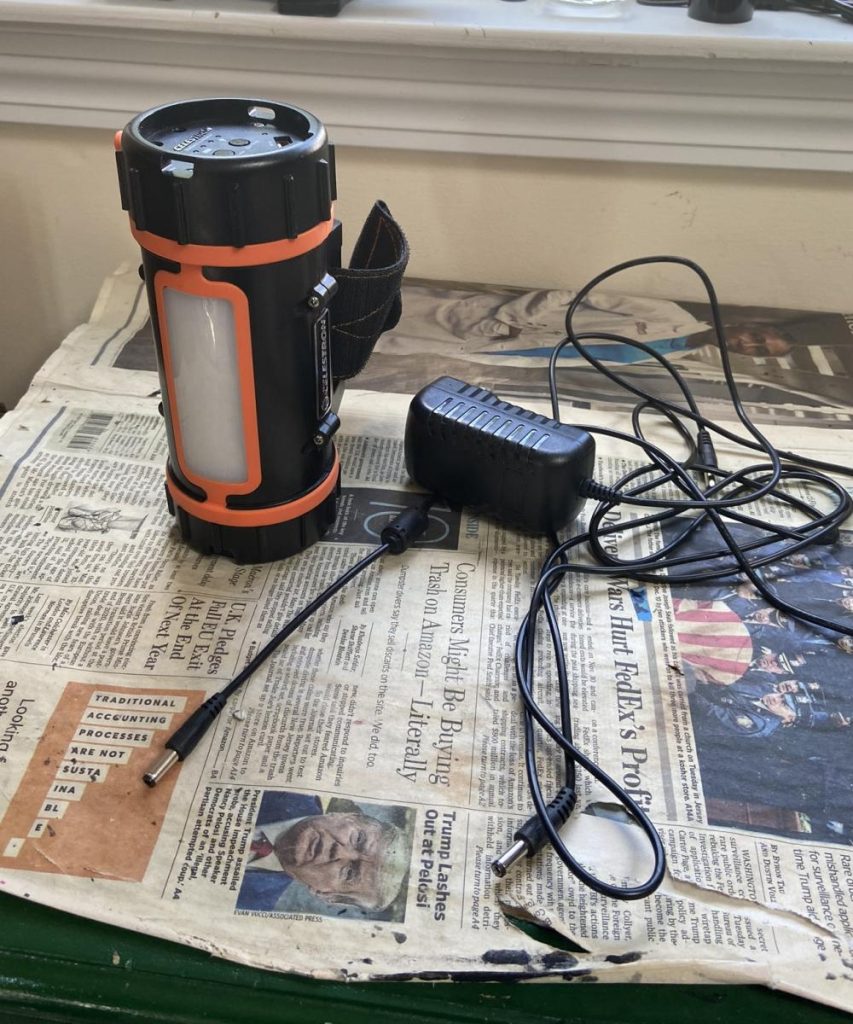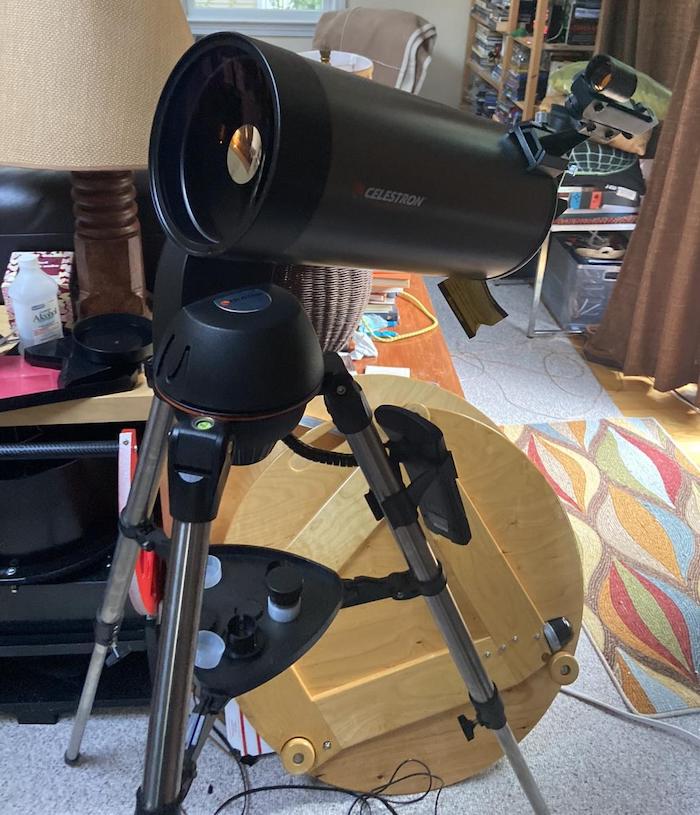Optical Tube Overview

- Stopped-down Aperture
The Celestron NexStar 127SLT computerised telescope is a 127mm f/12 Maksutov-Cassegrain with a focal length of around 1500 mm. At least that’s what Celestron says. But in practice, I found out that the primary mirror of the Celestron NexStar 127SLT Mak is slightly undersized, stopping it at about 120 mm in aperture. This is a minimal reduction, I agree. But it does make the scope a half f-stop slower, i.e., f/12.5 from the stated f/12.
- Focusing and Image Shift
Focusing the NexStar 127SLT is accomplished in the same manner as pretty much all Maksutov- and Schmidt-Cassegrains: by turning a knob on the back of the optical tube that slides the primary mirror on a threaded rod inside the tube, as shown in the diagram below.
I can say for sure that this system works. But due to the mirror slightly wobbling on the rod when it moves, it can cause an issue called image shift (the image appearing to rock back and forth). I only experienced a relatively low amount of image shift with the 127SLT, so I don’t want you to expect it to be a problem for visual use or astrophotography.

- Optical Tube’s Compatibility with Other Mounts

The NexStar 127SLT has a Vixen dovetail plate mounted on the right side of the optical tube. It’s sufficiently long that I can slide the scope on its mount to balance the scope if it is slightly front-heavy or back-heavy. I can also put the scope on a manual alt-az mount or an equatorial mount if I desire.
My Take On The Accessories
The Celestron NexStar 127SLT Maksutov comes with two eyepieces: a 25mm Kellner for low power (approximately 60x) and a 10mm Kellner for medium-high power (approximately 150x). These eyepieces worked pretty well when I tried. But Plossls would’ve been a little better and are usually what I’d expect at the 127SLT’s price point.
The 127SLT’s diagonal is a prism, and a nice one at that. It’s unlike the cheap diagonals I’ve seen being supplied with many entry-level scopes, which are cheap mirrors that aren’t very flat and tend to offer us dim and fuzzier images.
The NexStar 127SLT’s finderscope is the same generic “StarPointer” red dot LED device that comes on almost every beginner scope nowadays. I’ve found that it is well-made and sufficient for aligning the 127SLT’s GoTo system. You probably won’t have to use it again during your observing session once alignment is complete.
Incompatibility with Schmidt-Cassegrain Accessories
The Celestron NexStar 127SLT has a 1.25” visual back with a different thread system than Schmidt-Cassegrain accessories use. You can buy an aftermarket adaptor that allows the use of Schmidt-Cassegrain visual backs, adaptors, or a 2” diagonal.
A 2” diagonal along with long focal length eyepieces vignette the views slightly with the 127SLT, but a 2” wide-angle eyepiece allows us to achieve a wider true field of view. I had an uncomfortable level of vignetting with anything with a field stop of over 35mm or so. So I’d suggest you keep this in mind when shopping for eyepieces.
My testing also showed that an f/6.3 reducer meant for Schmidt-Cassegrains vignetted the views severely with the NexStar 127SLT. So better not to use it with the 127SLT.
The Barely Adequate Mount
The NexStar SLT mount is an evolution of the NexStar GT mount, which has been around since the early 2000s.
I believe that the 127mm Maksutov optical tube is about at the limit of what the SLT mount can handle. Other telescopes sold with the SLT mount, namely the 102mm f/6.5 refractor (NexStar 102SLT) and the 130mm f/5 Newtonian (NexStar 130SLT), are really pushing its capabilities and are wobbly as a result. The 127mm Maksutov optical tube is lighter and shorter than both of those, thus putting less strain on the mount.
The Mount’s GoTo Functionality & The Issues
The SLT mount is a GoTo. That means you just have to line it up with a couple stars when setting up the telescope. Then it loudly and automatically swings over to and tracks the target of your choice.
The NexStar SLT’s hand controller offers a database of about 4,000 objects. But I’d expect you to have a hard time observing all 4,000 of said objects because a good chunk of them are invisible or incredibly boring with the 120-mm aperture of the NexStar 120SLT.
The SLT mount needs 8 AA batteries, which, in my experience, get used up by the end of the second observation session or so. Obviously, that’s inconvenient and can be expensive for anyone. So I highly recommend biting the bullet and buying a dedicated DC power supply.

But I’d warn you not to forego the batteries in the scope. If the dedicated power supply diskonnects for even an instant when the battery compartment is empty, the scope will shut down, and we’ll have to realign it before continuing.
The scope also lacks an internal clock, so I have to set the time and date again every time I use it.
Should I buy a Used Celestron NexStar 127SLT?
The Celestron NexStar 127SLT Maksutov-Cassegrain is a great deal if you can get it used. Make sure to check that the electronics work and that the mount moves smoothly.
And if it’s an older unit with a non-USB hand controller, be prepared to pay a bit less.
Alternative Recommendations
The Celestron NexStar 127SLT has great optics, but it’s hobbled by its stopped-down aperture, less-than-adequate mount, and high price tag for what you get. There are certainly worse choices, but we have a lot of alternatives you might want to consider first even if you think the 127SLT is right for you.
Under £550
- The StellaLyra 8″ f/6 Dobsonian offers roughly triple the light-gathering ability and double the resolution of the NexStar 127SLT. Its short focal length and dual-speed Crayford focuser make it perfect for deep-sky object viewing, and it comes with a high-quality accessory bundle. And as always, a sturdy Dobsonian mount like the StellaLyra’s makes manual tracking and aiming at objects a breeze.
- The Ursa Major 8″ Dobsonian is an affordable, basic 8″ Dobsonian with straightforward features such as a single-speed 2″ Crayford focuser, 9×50 finder scope, and a set of quality Plossl eyepieces to begin your stargazing journey.
- The Sky-Watcher Virtuoso GTi 150P offers a 64% increase in light-gathering ability compared to the NexStar 127SLT, and like the 127SLT, it features fully motorised tracking and GoTo technology – though it uses no hand controller and instead can be controlled via your smartphone or tablet. The collapsable tube makes it easy to transport, and the short focal length provides a wider true field of view, perfect for deep-sky object observation. For an even more budget-friendly option, the Heritage 150P is identical to the Virtuoso GTi 150P but lacks electronics.
- The Sky-Watcher Skymax 127 AZ-GTi features the sam optical tube as the NexStar 127SLT mounted on the adaptable AZ-GTi mount and tripod, which includes motorised tracking GoTo functionality that can be manually moved or controlled via your smartphone. The Skymax 127 Virtuoso GTi uses the Virtuoso GTi tabletop Dobsonian mount, which can be attached to a third-party tripod if desired.
£550-£800 Range
- The StellaLyra 10″ f/5 Dobsonian offers more than double the resolution and quadruple the light-gathering ability of the NexStar 127SLT, with a sturdy Dobsonian mount and high-quality accessories. Like the 8” model, this telescope is a great choice for its performance and value for the money, and it’s hardly much heavier or harder to store compared to an 8” Dobsonian.
- The Bresser Messier 10″ Dobsonian features a smooth, sturdy mount, high-quality 10″ optics, and a reliable reflex sight finder, making it an excellent choice for those seeking a dependable telescope. However, it lacks some additional accessories found in competing models.
- The Explore Scientific 10” Ultra Light Dobsonian offers significantly better light-gathering power and resolution than the NexStar 127SLT, making it ideal for viewing all kinds of celestial objects. This compact and portable telescope collapses easily into a small cube and boasts a smooth Dobsonian mount that is both rock-solid and easy to aim.
- The Celestron StarSense Explorer 8” Dobsonian utilises StarSense Explorer technology to assist in locating targets in the night sky using your smartphone, although it does not come with many other features or accessories. It is a good option for those who want computerised functionality but still offers better performance and stability than the NexStar 127SLT.
Over £800
- The StellaLyra 12″ f/5 Dobsonian is a powerhouse of a telescope with an impressive range of accessories, offering excellent value for the money as with the smaller StellaLyra Dobsonians However, its solid tube can be a bit of a challenge to move around without a dolly and for transport to dark skies you’ll need a large vehicle. For those who can afford it, a more expensive collapsable or truss 12” tube may be a better option for ease of transportation and setup.
- The Celestron StarSense Explorer 10″ Dobsonian provides over four times the light-gathering ability and twice the resolving power compared to the NexStar 127SLT, while also including Celestron’s StarSense Explorer technology to help you locate celestial objects. The base is relatively lightweight for a 10″ Dobsonian, and transportation is made more accessible with cutouts in the base and handles on the tube. Although this telescope includes minimal accessories besides the StarSense Explorer technology, it delivers excellent value in terms of aperture and portability for its price.
- The Celestron NexStar 6SE is steadier than the NexStar 127SLT and provides comparable views of the Moon and planets, along with superior deep-sky views thanks to its larger aperture, and some astrophotography capabilities if fitted with a focal reducer and attached to an equatorial mount.
Aftermarket Accessory Recommendations
A dew shield for the NexStar 127SLT, as with any catadioptric telescope, is an extremely useful accessory which can help to minimise glare from nearby light sources entering the telescope, as well as to slow down frost or dew formation on the scope’s front corrector plate which can wreck your view and damage the corrector over time. The dew shield will also help protect the scope’s front corrector from fingerprints, pollen, and other common causes of damage to the sensitive optical coatings. It might also be beneficial to acquire a few additional eyepieces to enhance your collection. A 32mm Plossl eyepiece for 47x magnification with the NexStar 127SLT provides a slightly wider field of view and lower magnification than the provided 25mm eyepiece, making it more suitable for viewing deep-sky objects.
Additionally, the 127SLT’s stock 10mm eyepiece might be worth replacing with a 9mm redline or goldline (167x) for a smidge more power, sharper views, and greater eye relief along with a wider field of view. A 7mm planetary eyepiece (214x) maximises the usable magnification with the scope on a steady night, while a 15mm redline or goldline (100x) fits midway in magnification and focal length between the 127SLT’s included pair of eyepieces though you may or may not end up using one much.
Lastly, as with any motor-driven telescope, rechargeable power supply with a dependable lithium battery such as a Celestron PowerTank Lithium or a generic power pack like those offered by TalentCell is ideal for running the NexStar 127SLT without a need for a long extension cord or piles of AA batteries.
What can you see with Celestron NexStar 127SLT Mak?
The NexStar 127SLT’s f/12.5 focal ratio makes it a little more suitable for deep-sky than some of the competing GoTo Maksutovs, but it really still limits what I can see.
- The best deep-sky objects to observe with small scopes are large nebulae, which are so spread out that they’re simply invisible with the 127SLT, and open clusters, some of which don’t fit in the field of view even at low power.
- The scope’s meagre 120mm aperture means I can’t resolve many globular clusters, and planetary nebulae big and bright enough for a 120mm scope are few and far between.
Really, the 127SLT is a lunar and planetary scope, and for that, you don’t need the GoTo at all.
- Mercury and Venus’ phases can be seen.
- The 120mm aperture is enough to resolve a few dark patches and the ice cap on Mars.
- Jupiter and Saturn display a wide array of features and moons.
- Uranus and Neptune, invisible to the naked eye, are uninteresting with the 127SLT and appear as little more than bluish dots.
Astrophotography: Useless for Deep-Sky and Decent for Planetary
The lightweight, alt-azimuth SLT mount combined with the 127SLT’s f/12.5 focal ratio means it is utterly useless for deep-sky imaging.
However, I could do a decent job imaging the Moon and planets with an inexpensive CMOS camera and a 2x Barlow lens. The only other prerequisite is a laptop with a decent amount of RAM and lots of hard drive space.
If you have a DSLR, you can also use it with a 2x or, preferably, 3x Barlow lens with or without a laptop (a laptop allows for more control over the camera) and get equally good results. But the DSLR will strain the mount more, so if you don’t already have a camera, I’d choose a CMOS instead.


